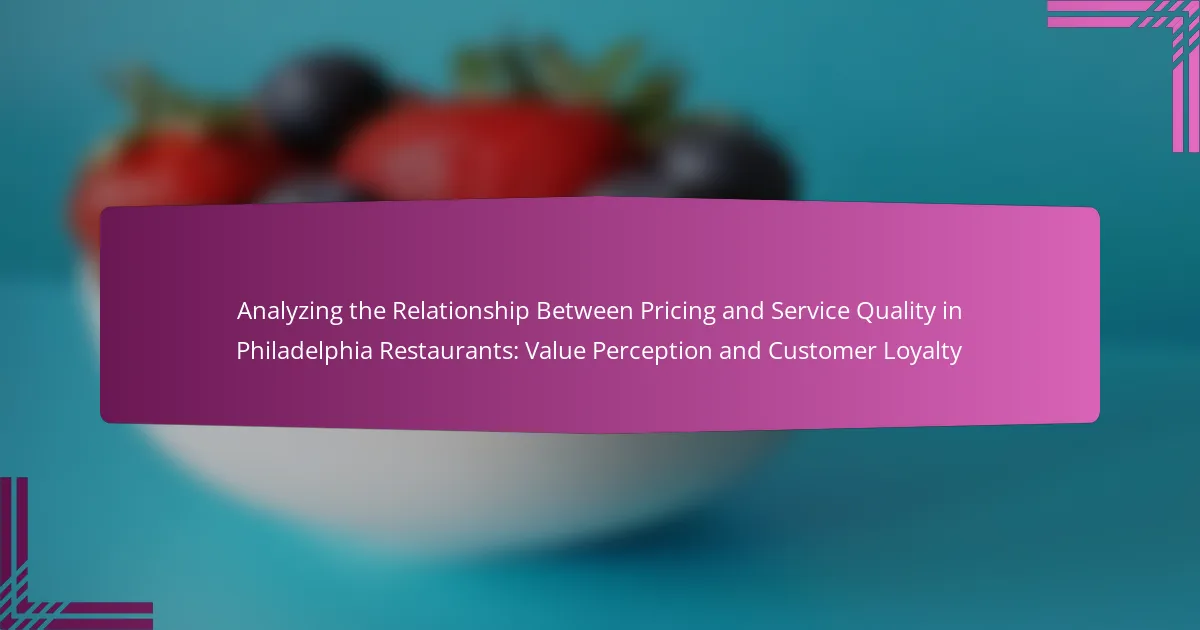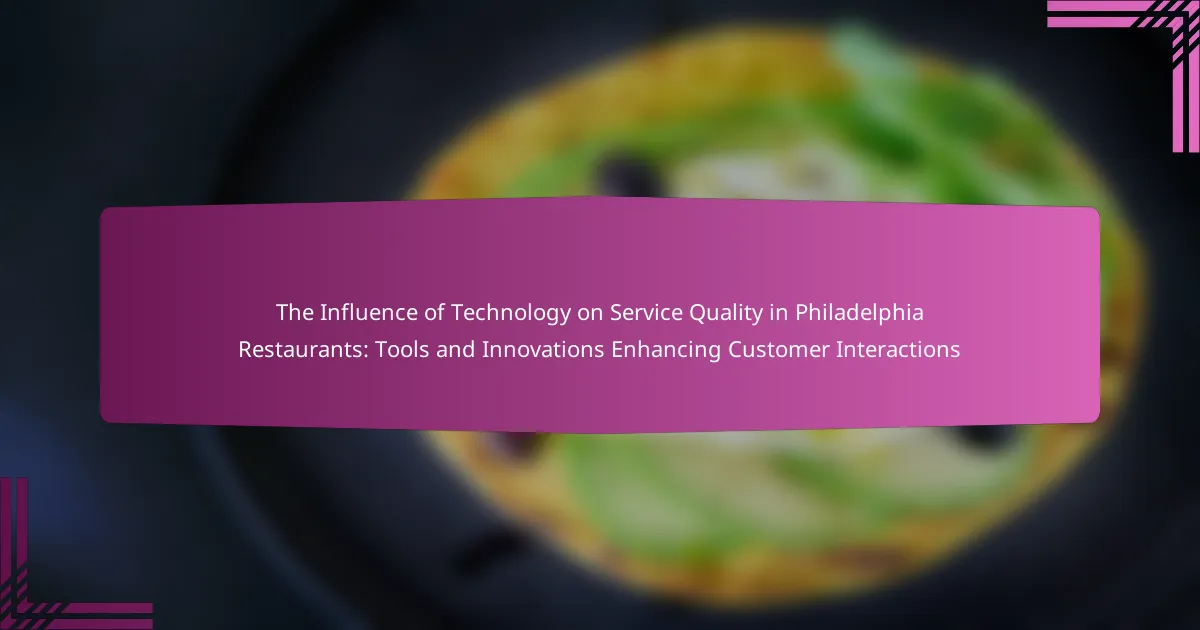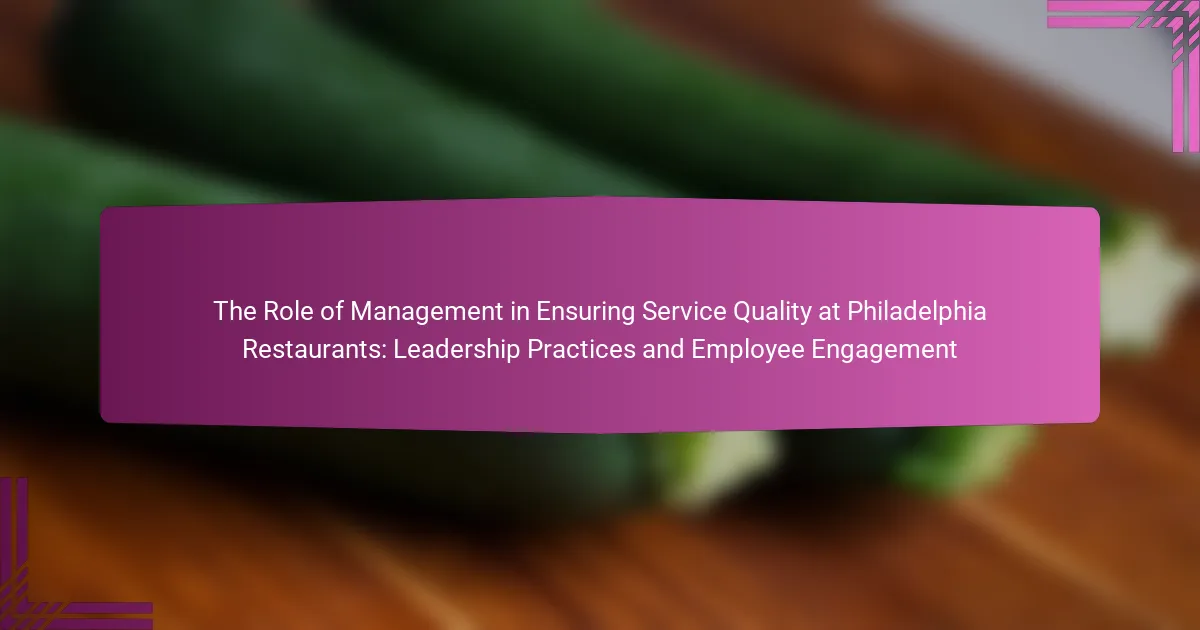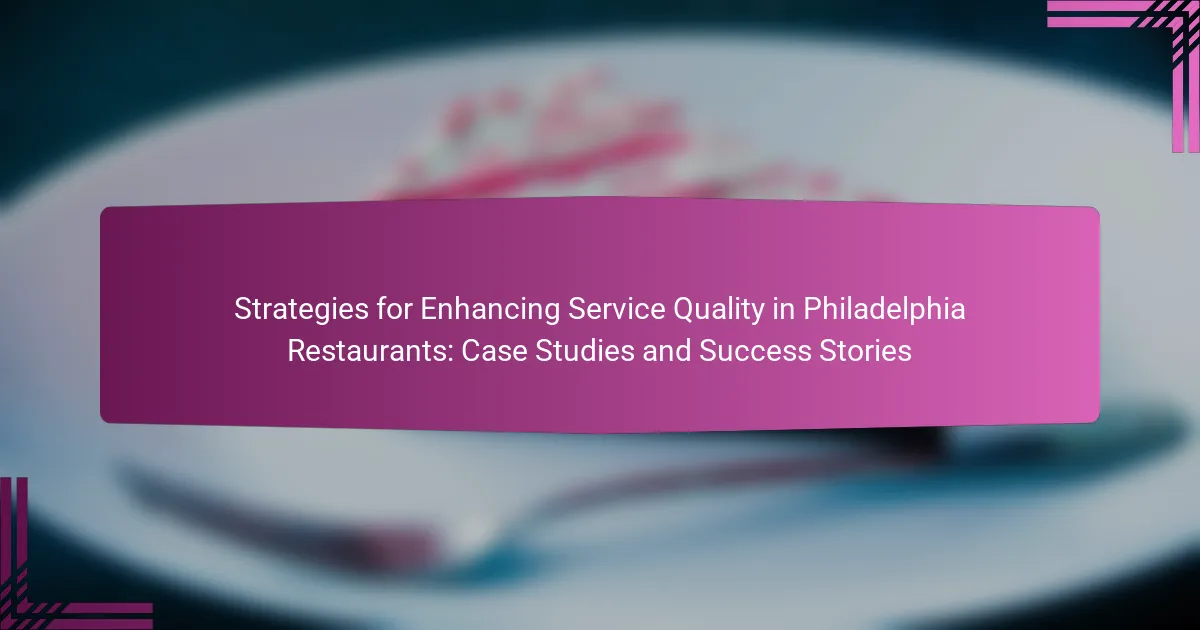
What is the relationship between pricing and service quality in Philadelphia restaurants?
Pricing and service quality in Philadelphia restaurants are often positively correlated. Higher prices typically suggest better service quality. This relationship is influenced by customer expectations. Patrons expect superior service when they pay more. Studies indicate that customers associate higher prices with enhanced dining experiences. For instance, a survey by the National Restaurant Association found that 70% of diners believe price reflects quality. In Philadelphia, restaurants that maintain higher price points often invest in staff training. This investment leads to improved service delivery. Consequently, customers are more likely to return to establishments that provide both quality service and fair pricing.
How do pricing strategies influence customer perceptions of service quality?
Pricing strategies significantly influence customer perceptions of service quality. Higher prices often signal higher quality to consumers. This is based on the concept of price-quality inference, where customers assume that more expensive services are superior. Conversely, low prices may lead customers to perceive a service as inferior. Research shows that customers often equate higher prices with better service experiences. A study published in the Journal of Retailing found that price increases can enhance perceived service quality. This relationship is critical in competitive markets like Philadelphia restaurants. Customers’ willingness to pay more can lead to greater satisfaction and loyalty.
What specific pricing models are commonly used in Philadelphia restaurants?
Common pricing models used in Philadelphia restaurants include a la carte, prix fixe, and buffet pricing. A la carte pricing allows customers to choose individual dishes at set prices. This model provides flexibility and caters to varying customer preferences. Prix fixe pricing offers a set menu at a fixed price, often providing multiple courses. This model can enhance perceived value and streamline kitchen operations. Buffet pricing allows customers to pay a flat fee for unlimited food access. This model can increase customer satisfaction by offering variety. Each model addresses different customer needs and can influence service quality and value perception.
How does perceived value change with different pricing strategies?
Perceived value changes significantly with different pricing strategies. When prices are set higher, customers often associate the product or service with higher quality. This phenomenon is known as the price-quality heuristic. Conversely, lower pricing strategies may lead to perceptions of lower quality. Research indicates that consumers often use price as a cue to evaluate value. A study published in the Journal of Consumer Research found that consumers perceive higher-priced items as more desirable. Additionally, promotional pricing can create a sense of urgency, enhancing perceived value temporarily. Overall, the relationship between pricing strategies and perceived value is crucial in shaping customer loyalty, particularly in competitive markets like Philadelphia restaurants.
Why is understanding value perception critical for restaurant success?
Understanding value perception is critical for restaurant success because it directly influences customer satisfaction and loyalty. Value perception encompasses how customers evaluate the quality of food and service relative to the price they pay. Research shows that customers who perceive high value are more likely to return and recommend the restaurant to others. For example, a study by Zeithaml (1988) found that perceived value significantly affects customer retention in the hospitality industry. Additionally, effective pricing strategies aligned with perceived value can enhance competitive advantage. Restaurants that successfully manage value perception can increase profitability and build a loyal customer base.
What role does customer loyalty play in the pricing-service quality relationship?
Customer loyalty significantly influences the pricing-service quality relationship. Loyal customers often perceive higher value in service quality. They are willing to pay premium prices for consistent and superior service. This willingness stems from their trust in the brand and past positive experiences. Research indicates that businesses with high customer loyalty can maintain higher prices without losing clientele. For example, a study by Kumar and Shah (2004) found that loyal customers contribute to increased profitability through repeat purchases. Thus, customer loyalty acts as a buffer in the pricing-service quality dynamic, allowing businesses to leverage service quality for higher pricing strategies.
How do customers define value in the context of dining experiences?
Customers define value in dining experiences as the balance between quality, service, and price. They expect high-quality food that meets their taste preferences. Additionally, attentive and friendly service enhances their overall satisfaction. Customers also consider the ambiance and cleanliness of the restaurant as significant factors. The perceived value increases when the dining experience exceeds their expectations. Research indicates that customers are willing to pay more for superior service and unique culinary offerings. A study published in the Journal of Hospitality Marketing & Management found that perceived value directly influences customer loyalty. This highlights the importance of delivering exceptional experiences to retain customers.

What factors contribute to customer loyalty in Philadelphia restaurants?
Customer loyalty in Philadelphia restaurants is influenced by several key factors. Consistent food quality is paramount; diners return for dishes that meet their expectations. Exceptional service also plays a critical role. Friendly and attentive staff enhance the dining experience. Price fairness significantly affects loyalty; customers appreciate perceived value for their money. Unique menu offerings can attract repeat visits. Additionally, a welcoming atmosphere encourages customers to return. Community engagement, such as supporting local events, builds a positive brand image. Lastly, customer feedback loops, including responsiveness to reviews, strengthen relationships and foster loyalty.
How does service quality impact repeat visits from customers?
Service quality significantly influences repeat visits from customers. High service quality leads to increased customer satisfaction. Satisfied customers are more likely to return. According to a study by Zeithaml et al. (1996), service quality directly impacts customer loyalty. The research indicates that customers who perceive high service quality are more inclined to revisit. Additionally, a survey by the American Customer Satisfaction Index found that 70% of customers return due to positive service experiences. Thus, effective service quality fosters customer loyalty and repeat business.
What specific attributes of service quality are most valued by customers?
The specific attributes of service quality most valued by customers include reliability, responsiveness, assurance, empathy, and tangibles. Reliability refers to the ability to deliver promised services consistently. Customers expect services to be performed accurately and dependably. Responsiveness is the willingness to help customers and provide prompt service. Quick responses to inquiries and complaints enhance customer satisfaction. Assurance encompasses the knowledge and courtesy of employees, instilling confidence in customers. Empathy involves providing caring, individualized attention to customers. Finally, tangibles include the physical facilities, equipment, and appearance of personnel, which contribute to the overall perception of service quality. These attributes collectively influence customer loyalty and satisfaction in the restaurant industry.
How does the consistency of service affect customer loyalty?
Consistency of service significantly enhances customer loyalty. When customers receive reliable and predictable service, they develop trust in the brand. Trust leads to repeat business and positive word-of-mouth referrals. Research indicates that 70% of customers value consistency in service quality. This consistency fosters a sense of belonging and satisfaction among customers. In the competitive restaurant industry, consistent service can differentiate a brand from its competitors. High service consistency correlates with higher customer retention rates. Therefore, businesses that prioritize service consistency are more likely to cultivate loyal customer bases.
What are the implications of pricing on customer loyalty?
Pricing significantly influences customer loyalty. When prices are perceived as fair, customers are more likely to return. Competitive pricing can enhance loyalty by creating a sense of value. Conversely, high prices may deter repeat business if customers feel they are not receiving adequate value. Research indicates that 70% of consumers are willing to pay more for better service. This suggests that pricing strategies must align with perceived service quality. Additionally, discounts and loyalty programs can reinforce customer retention. A study found that 60% of loyal customers are influenced by promotional pricing. Thus, effective pricing strategies are crucial for fostering customer loyalty in restaurants.
How do discounts and promotions influence customer retention?
Discounts and promotions significantly enhance customer retention. They create immediate value for customers, making them more likely to return. When customers perceive they are receiving a good deal, their satisfaction increases. This satisfaction leads to a stronger emotional connection with the brand. Research indicates that 60% of consumers are more likely to remain loyal to brands that offer promotions. Additionally, discounts can incentivize repeat purchases, increasing overall spending. In the restaurant industry, targeted promotions can lead to a 20% increase in customer visit frequency. Thus, effective use of discounts and promotions can directly correlate with improved customer loyalty and retention rates.
What is the relationship between perceived fairness in pricing and loyalty?
Perceived fairness in pricing directly influences customer loyalty. When customers feel that prices reflect the value of the service received, they are more likely to return. This perception fosters trust between the customer and the restaurant. A study by Kwortnik and Thompson (2009) found that fairness in pricing significantly correlates with customer satisfaction. Increased satisfaction leads to repeat visits and positive word-of-mouth. Conversely, perceived unfair pricing can lead to dissatisfaction and loss of loyalty. Thus, maintaining fair pricing is crucial for retaining customers in the competitive restaurant industry.
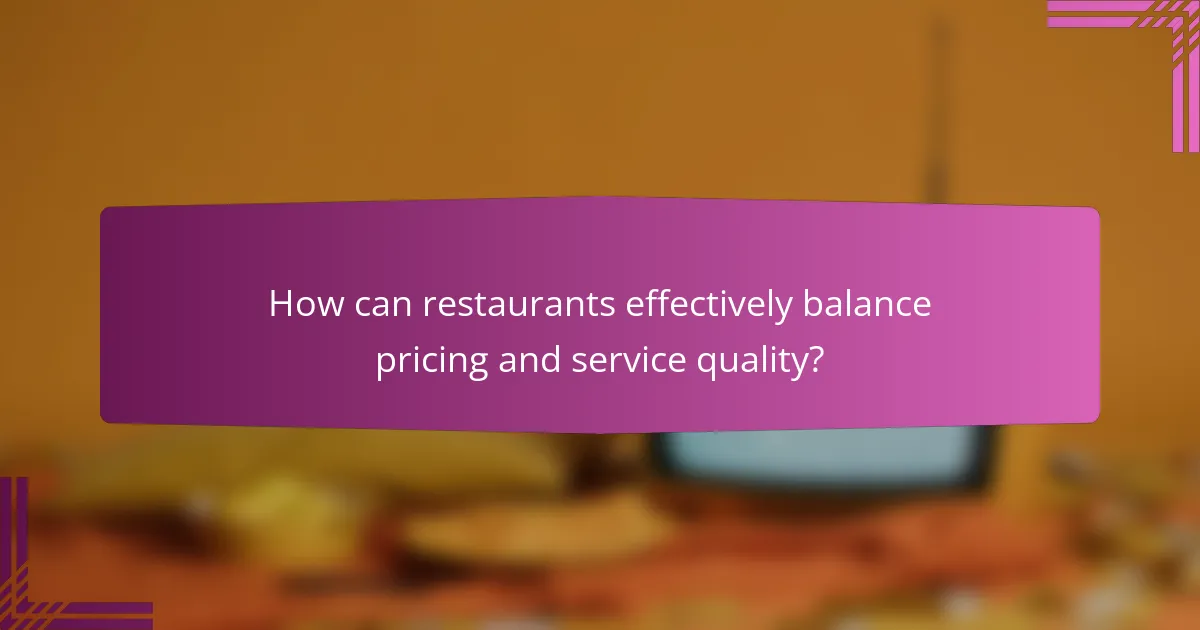
How can restaurants effectively balance pricing and service quality?
Restaurants can effectively balance pricing and service quality by implementing strategic pricing models and enhancing customer service training. Strategic pricing models involve analyzing competitor prices and customer demographics to set appropriate price points. This ensures that prices reflect the quality of service and food offered. Enhanced customer service training equips staff with the skills to meet customer expectations, which can justify higher prices. Research indicates that restaurants with higher service quality can charge 10-20% more than competitors with average service. Additionally, gathering customer feedback helps restaurants adjust their offerings to meet market demands. This approach fosters customer loyalty, leading to repeat business and positive reviews.
What strategies can restaurants implement to enhance perceived value?
Restaurants can enhance perceived value by improving service quality and menu presentation. High-quality service creates a positive dining experience. Staff training is essential for delivering exceptional customer service. Engaging with customers can foster a connection and increase satisfaction.
Menu presentation plays a crucial role in perceived value. Visually appealing menus can attract attention and enhance the dining experience. Using descriptive language for dishes can stimulate interest and appetite. Offering unique or seasonal items can create a sense of exclusivity.
Pricing strategies also impact perceived value. Competitive pricing can attract budget-conscious customers. Bundling items or offering value meals can provide a perception of savings. Transparency in pricing helps build trust with customers.
Additionally, implementing loyalty programs can encourage repeat visits. Offering rewards for frequent diners can enhance customer loyalty. Positive reviews and word-of-mouth recommendations further boost perceived value.
In a study by the Journal of Hospitality Marketing & Management, service quality significantly influences customer satisfaction and perceived value. This correlation highlights the importance of service in enhancing the overall dining experience.
How can training staff improve service quality without increasing costs?
Training staff can improve service quality without increasing costs by enhancing employee skills and efficiency. Well-trained staff can address customer needs more effectively. This leads to increased customer satisfaction and loyalty. Satisfied customers are likely to return, reducing the costs associated with acquiring new customers. Research shows that investing in training can lead to a 24% increase in customer satisfaction. This is evidenced by a study conducted by the American Society for Training and Development, which found that companies with comprehensive training programs experience higher employee performance and customer retention. Thus, effective staff training can lead to better service quality and lower operational costs.
What role does customer feedback play in refining pricing and service strategies?
Customer feedback is crucial in refining pricing and service strategies. It provides insights into customer preferences and perceptions of value. Restaurants can adjust pricing based on feedback about perceived value versus actual cost. Feedback also highlights service quality issues that may affect customer satisfaction. By analyzing customer comments, restaurants can identify specific areas for improvement. This can lead to enhanced service quality, which in turn can justify pricing adjustments. Studies show that businesses that actively seek and implement customer feedback see increased customer loyalty. For instance, a report by the Harvard Business Review indicates that companies using feedback effectively can boost their revenue by up to 10%.
What best practices can Philadelphia restaurants adopt to improve customer loyalty?
Philadelphia restaurants can improve customer loyalty by implementing personalized service, consistent quality, and loyalty programs. Personalized service creates a connection with customers, making them feel valued. Consistent quality in food and service builds trust and encourages repeat visits. Loyalty programs incentivize frequent dining through rewards, enhancing customer retention. According to a study by the National Restaurant Association, 73% of consumers are more likely to return to a restaurant that offers a loyalty program. Additionally, engaging with customers through social media fosters community and keeps them informed about promotions. These practices create a positive dining experience that encourages loyalty.
How can restaurants leverage customer loyalty programs effectively?
Restaurants can leverage customer loyalty programs effectively by offering personalized rewards that resonate with their customers. Tailoring rewards to individual preferences increases engagement and satisfaction. For example, a study found that personalized offers can lead to a 20% increase in customer retention. Additionally, implementing tiered loyalty programs encourages customers to spend more to reach higher levels of rewards. Research indicates that tiered systems can boost average transaction values by 15%. Regularly communicating with customers about their rewards and program benefits keeps them informed and engaged. Data shows that effective communication can enhance customer participation by up to 30%. Lastly, gathering feedback on loyalty programs allows restaurants to refine their offerings. This approach can lead to a 10% improvement in customer loyalty metrics when adjustments are made based on customer input.
What are the key metrics to track for assessing customer satisfaction and loyalty?
Key metrics to track for assessing customer satisfaction and loyalty include Net Promoter Score (NPS), Customer Satisfaction Score (CSAT), and Customer Effort Score (CES). NPS measures the likelihood of customers recommending a brand. A high NPS indicates strong loyalty. CSAT gauges customer satisfaction with a specific interaction or overall experience. A higher CSAT reflects better service quality. CES evaluates how easy it is for customers to resolve issues. Lower effort correlates with higher satisfaction and loyalty. Tracking these metrics provides actionable insights into customer perceptions and behaviors.
The main entity of this article is the relationship between pricing and service quality in Philadelphia restaurants, with a focus on value perception and customer loyalty. The article examines how pricing strategies influence customer perceptions of service quality, highlighting the positive correlation between higher prices and enhanced service experiences. It also explores various pricing models, the impact of perceived value on customer loyalty, and the critical role of service quality in fostering repeat visits. Additionally, the article discusses best practices for restaurants to improve customer loyalty, including personalized service and effective loyalty programs, while emphasizing the importance of customer feedback in refining pricing and service strategies.
